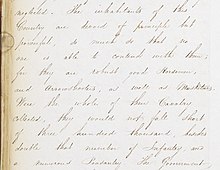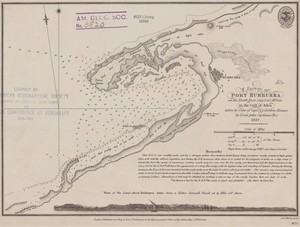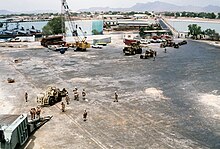Berbera
[8] Residents still head for milder weather in the summer, a vacation tradition called xagaa-bax, which is also common in other coastal cities (e.g. Djibouti, Bosaso).
There are imported into this place the things already mentioned, and many tunics, cloaks from Arsinoe, dressed and dyed; drinking-cups, sheets of soft copper in small quantity, iron, and gold and silver coin, but not much.
There are exported from these places myrrh, a little frankincense, (that known as far-side), the harder cinnamon, duaca, Indian copal and macir, which are imported into Arabia; and slaves, but rarely.
[16] Berbera, along with Zeila, were the two most important ports situated inside the Adal Sultanate, and they provided vital political and commercial links with the wider Islamic World: To Adea belongs a very good Port, call’d Barraboa, whoſe chief City is Arat, obeys a King, who is an enemy to the Abiſſines.
[17] To Adel belongs a very good port, called Barbara, whose chief city is Harar, obeys a King, who is an enemy to the Abyssinians.
Further noting the Somali inhabitants adhering to the Shafi'i school of Sunni Islam significant trade came from Harar in the interior alongside Gondar and Shewa.
Cloth, rice and tobacco came from Kutch in Gujarat and Muscat with Mocha, Jeddah and Al Mukalla being the source of dates and tin.
Punkar stated that the Somalis of the area were skilled musketeers and possessed powerful cavalry and knowledge of archery, but were often internally divided except for when united against common enemies.
All foreigners including Arabs and Indians who often frequented Berbera were prohibited from venturing further inland, lest they access the lucrative trade of Harar directly and bypass the Somalis.
[23] One certainty about Berbera over the following centuries was that it was the site of an annual fair, held between October and April, which Mordechai Abir describes as "among the most important commercial events of the east coast of Africa.
"[24] The major Somali sub-clans of the Isaaq in Somaliland, caravans from Harar and the interior, and Banyan merchants from Porbandar, Mangalore and Mumbai gathered to trade.
[27] During the 1833 trading season, the port town swelled up to 70,000 people, and upwards of 6,000 camels laden with goods arrived from the interior within a single day.
Berbera was the main marketplace in the entire Somali seaboard for various goods procured from the interior, such as livestock, coffee, frankincense, myrrh, acacia gum, saffron, feathers, wax, ghee, hide (skin), gold and ivory.
From the beginning of November to the end of April, a large fair assembles in Berbera, and caravans of 6,000 camels at a time come from the interior loaded with coffee, (considered superior to Mocha in Bombay), gum, ivory, hides, skins, grain, cattle, and sour milk, the substitute of fermented drinks in these regions; also much cattle is brought there for the Aden market.”[30]Historically, the port of Berbera was controlled indigenously between the mercantile Reer Ahmed Nur (Ayyal Ahmed) and Reer Yunis Nuh (Ayyal Yunis) sub-clans of the Sa'ad Musa, Habr Awal.
These two sub-clans effectively administered the trade of the town, especially in the dealings of all transactions and brokerage between various parties to issuing protection agreements towards the foreign Arab and Indian traders.
[31] With the backing of Haji Sharmarke Ali Saleh, the Reer Ahmed Nuh drove out their kinsmen and declared themselves the sole commercial masters of Berbera.
[32] The defeated Reer Yunis Nuh moved westwards and established the port of Bulhar which later, for a brief period, became a trading rival to nearby Berbera.
[36] In addition, Mocha, Aden, Jeddah and several other ports in Arabia had constant contact with Berbera in regard to general trade and commerce.
[37] In the early years of the nineteenth century, the local Somalis of Berbera (Habr Awal clan) had a navigation act where they excluded Arab vessels and brought the goods and produce of the interior in their own ships to the Arabian ports: Berbera held an annual fair during the cool rain-free months between October and April.
These goods in the early nineteenth century were almost exclusively handled by Somalis who, Salt says, had "a kind of navigation act by which they exclude the Arab vessels from their ports and bring the produce of their country either to Aden or Mocha in their own dows.
Backed by lands capable of cultivation, and by hills covered with pine and other valuable trees, enjoying a comparatively temperate climate, with a regular although thin monsoon, this harbour has been coveted by many a foreign conqueror.
A British officer visiting the city from Aden noted the guards would not betray the Reer Ahmed Nur save death.
[42] When a British vessel named the Mary Anne attempted to dock in Berbera's port in 1825 it was attacked and multiple members of the crew were massacred by the Habr Awal.
[43] In 1827 two years later the British arrived and extended an offer to relieve the blockade which had halted Berbera's lucrative trade in exchange for indemnity.
[45] They had numerous commercial ties with the Somalis, leading vessels from Ras Al Khaimah and the Persian Gulf to regularly attend trade fairs in the large ports of Berbera and Zeila and were very familiar with the Isaaq.
Despite Berbera's strategic location, being the only port with a sheltered harbor on the southern side of the Gulf of Aden (the gateway to the Suez Canal), the British later came to regret their nominal control of the region.
In fact, Winston Churchill once visited Berbera in 1907 when he was Under-Secretary of State for the Colonies, and he noted the protectorate be abandoned, since it was "unproductive, inhospitable, and the people are very hostile to occupation.
[57] The Somalis serving in the Somaliland Camel Corps were given the choice of evacuation or disbandment; the majority chose to remain and were allowed to retain their arms.
[63] Coinciding with the Ogaden War between The Somali Republic and Ethiopia in 1977, the Soviets left Berbera and the nation as a whole due to a disagreement, leaving the United States to arrive with a $40 million investment and new health facilities in 1980.
The second phase includes extending the new quay from 400 to 1,000 metres, and adding seven more ship-to-shore gantry cranes, bringing the total to ten and enabling the expanded port to handle up to two million TEU containers a year.

















